In the Centennial Footsteps of the Great War from Sarajevo to Versailles VOL I by Attila Szalay-Berzeviczy
- Home
- World War I Book Reviews
- In the Centennial Footsteps of the Great War from Sarajevo to Versailles VOL I by Attila Szalay-Berzeviczy
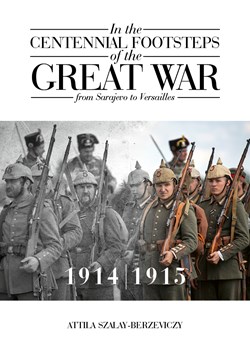
Attila Szalay-Berzeviczy, Hungary’s Ambassador to France, ambitiously aims to ‘help prevent the Third World War’ with his book, ‘In the Centennial Footsteps of the Great War from Sarajevo to Versailles VOL I.’ He believes that by understanding the reasons and consequences of the First World War, we can gain insights into all wars, including the potential for a third world war. The book is a comprehensive historical travelogue featuring hundreds of photographs depicting battlefields, official commemorations, and historical reenactments, bringing the past to life. Szalay-Berzeviczy’s unique perspective offers a profound look into the Great War’s impact on the 20th century and its lasting legacy.
It is an ambitious author and photographer who states that his book aims to ‘help prevent the Third World War’, but from someone who is now Hungary’s Ambassador to France, I applaud his ambition that if we ‘understand the reasons and the consequences of the First World War’, we can understand the reasons and consequences of all war, let alone the first, second and plausible third world wars and all that has gone on meantimes.
There are many times when I feel the book should accompany a BBC TV series, one in which Attila treks the globe like Michael Palin, visiting sites, attending events, and speaking to locals, dignitaries, and visitors.
The First World War did indeed ‘change the world forever and shaped the 20th century’, and as George von Habsburg states in his introduction, ‘If we do not understand the suffering caused by a worldwide conflict, we can become careless with peace’.
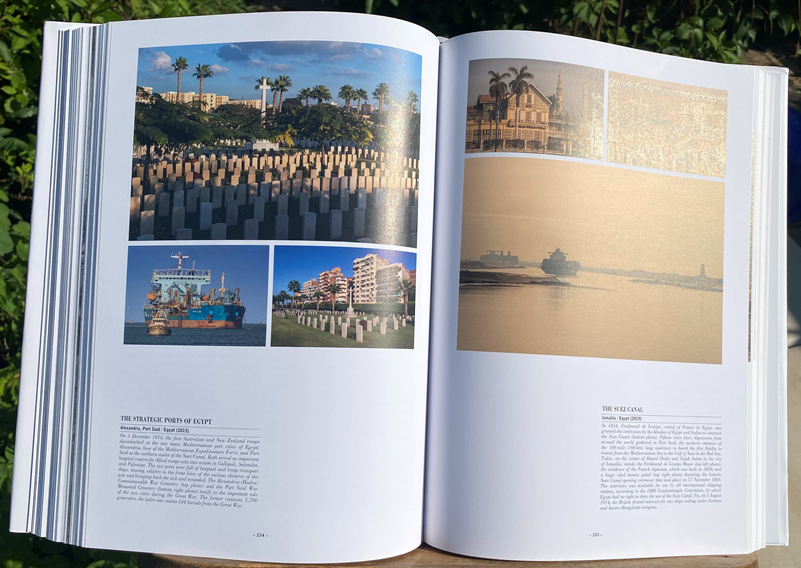
There are hundreds of photographs depicting battlefields, official commemorations, and the work of historical reenactors all from today’s perspective, echoing the past in the present.
If, like me, you have wrestled with reenactment, especially if you still feel close to a grandfather, grandmother or great-uncle you knew who served or simply lived and endured these times, then you have to consider the value of bringing elements of the past to life for a new generation. Like Waterloo or even the Battle of Crecy, the First World War has become something that happened outside living memory. The individual reenactor and those enjoying their reenactment are connecting with the past and keeping the memory of that event alive, as others do through books, museums, videos and blogs.
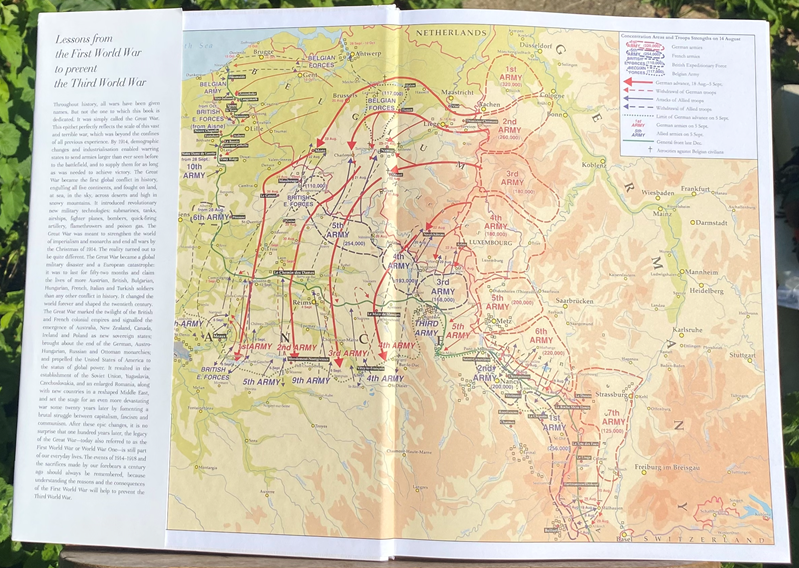
You get several impressions when you first pick up a copy of Attila Szalay-Berzeviczy’s In the Centennial Footsteps; it is a weighty tome, an ambitious undertaking and wonderfully executed with succinct text covering battles and events on every front, set carefully in historical and geographic context, with references back through the centuries to explain actions that came from previous conquests, empire building, colonialism and global trade. It is a travel guide, not that I’m about to put this or two volumes in a trunk to take on my travels. Still, you dream about visiting some of these locations and the accompanying museums, such as the Sarajevo Museum 1878-1918 and The Museum of Military History in Vienna.
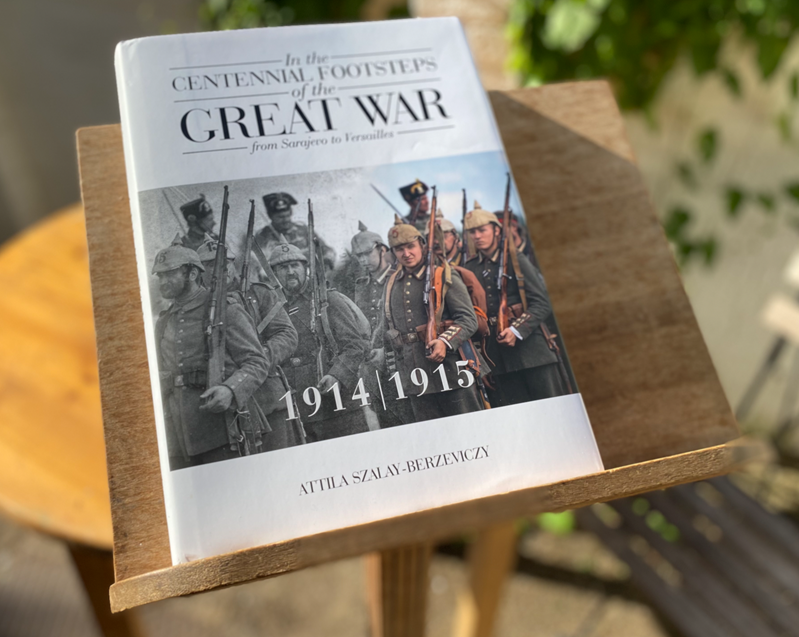
My review of Volume I sits on a wooden reading stand I acquired from an antique shop. Having now read it cover to cover and enjoyed pursuing the many hundreds of original photographs, it will join other reference volumes of this calibre, such as a Times Atlas of the First World War and volumes on the art of the Great War.
There are more pages of photographs than text; whilst I read my copy of ‘In the Centennial Footsteps’ from cover to cover over six weeks, it invites you to browse, dip into a chapter and flick through the collections of photographs featured with each story. I have too many favourites to list, but capturing the essence of events over one hundred years ago using contemporary photographs is no mean feat.
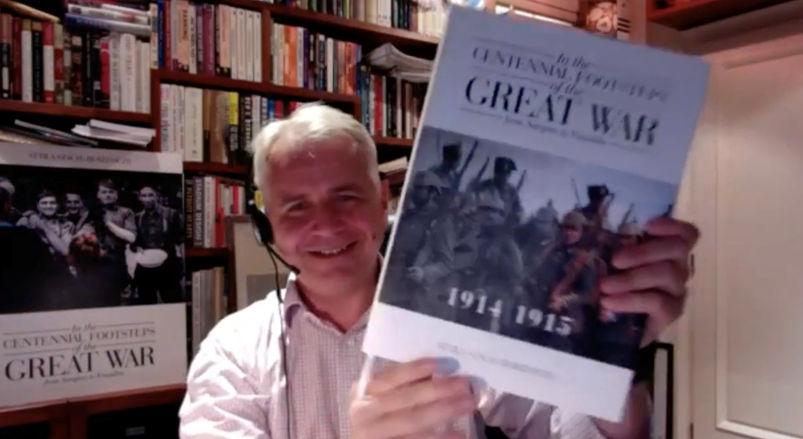
Attila Szalay-Berzeviczy has an eye for capturing what we know can be a challenging topic: cemeteries, gravestones and monuments while using a director's eye to shoot reenactors that makes you feel you are on the set of a grand cinematic undertaking. It is, as he states, ‘very different to anything published before and unrepeatable’ - the kind of centennial events we witnessed between 2014 and 2018 marking the First World War may only return in a different form when the Second World War’s centennial is marked between 2039 and 2045.
The soul of In the Centennial Footsteps … emanates from central and eastern Europe, spreading across all five continents, taking an actual world perspective in equal measure. Created for and of the centenary, ‘In the Centennial Footsteps …’ is not shy to look back across the century before the ‘first’ world war and to the century since, with the Second World War and the Cold War, even speculating what lessons we may or may not have learnt regarding the likelihood and causes of a third world war. This makes ‘In the Centennial Footsteps …’ such a unique and comprehensive adventure: the First World War is seen as a tipping point between the 19th and 20th centuries.
Following the prologue, forward and ‘in memory of … ‘, each worth reading in their own right, we come to the first chapter on ‘the Sarajevo Assassination’. It’s easy to think that we know this story, that the motives, maps and itineraries have been spelt out to us. Still, the joy of In the Centennial Footsteps … is that we experience the author's visit to the locations, his investigations and keen photography, making the book both a history and a travelogue. As we in Britain, as well as in France, Canada, Australia, and New Zealand, and to a lesser degree in the US, made a great fuss about commemorating the First World War, other countries did not do so. Therefore, It is apt that this journey inevitably starts in Sarajevo, where on 28 June 2014, there was no united commemoration at all, nor indeed any kind of memorial. Visits to The Sarajevo Museum 1878-1918 and The Museum of Military History in Vienna are recommended. I feel like I'm planning a trip already.
For now, my journey is to read on and on, sure that the text will be as insightful and well-written as the photographs that have been researched and created.
In the Centennial Footsteps … was eight years in the making - and there’s a second volume to come. Attila Szalay-Berzeviczy visited all five continents and created images to help tell stories of the war on land, at sea and in the air, on distant battlefields on every front.
The author is convinced that the First World War ‘changed the world forever and shaped the 20th century,’ which it did, and that ‘understanding the reasons and the consequences of the First World War will help prevent the Third World War’. However, this economist and former President of the Budapest Stock Exchange unwittingly appeared to quote business and government leaders speaking in the summer of 1914 when they suggested (and hoped) that a major European war was impossible at the time, given how closely our countries were aligned economically - this despite Russia’s invasion of the Crimea and Donbas in 2014 and of course, a sentiment expressed long before Russia invaded Ukraine.
George von Habsburg, son of Otto von Habsburg, the last Crown Prince of Austria-Hungary, recalls the Battle of Austerlitz of 2 December 1805, along with the Treaty of Schönbrun and the Battle of Waterloo, which, in hindsight, can be seen to have marked the beginning of a century of peace (though not, I might point out, so peaceful for the millions of subjects in dominion countries and European-controlled colonies around the world).
The Sarajevo Assassination
On 28 June 2014, the assassination of Archduke Ferdinand went unmarked despite the cataclysm it set off—though a statue was put up of the assassin Princip, and Serbia bizarrely now also has a statue of Tsar Nicholas II, which suggests to what degree the celebration or rather commemoration of any historical event catches national sentiment and changing perspectives.
The mobilisation was a precursor to war in 1914; the world saw this when Russia mobilised in such numbers before invading Ukraine. And was not the Kaiser as deluded as Putin when he expected to achieve a ‘quick and resounding military victory’? We should be aware of delusions of power and conscious of the innate human desire for freedom, or at least a sense of it, within the boundaries of our sovereign state. Based on what I have learnt about him, I'm not convinced that the Kaiser ever wanted peace - instead, he was chief amongst the warmongers. I would turn to his British Ambassador and other European voices who tried to avoid war. This is one of just a couple of misconceptions I have found in ‘In the Centennial Steps …’ The other is regarding the student regiment that was supposedly wiped out at Langemark and is commemorated and celebrated in the iconic cemetery there, which I understand was a propaganda story developed by the Nazis.
There are dates and battles I have been introduced to and reminded of that I will now never forget; ‘In the Centennial Footsteps … ‘makes a case for us to bring to the fore all kinds of battles because it is essentially a book about battles, how they were lost or won, and their significance, such as the First Habsburg invasion of Serbia, which was thwarted 15-24 August 1914.
Attila calls The Battle of Cer ‘the First Allied victory of the First World War’, which began on the 15th of August. It is remembered every year and was celebrated on 24 August 2014 at Tekeri. The Battle of the Drina, 7 September - 4 October 1914, is marked in Serbia with reenactors in a way the Scots may mark Bannockburn or the English Waterloo. I shouldn’t consider it strange, given that I live in a town that marked the 750th anniversary of the Battle of Lewes with reenactors fighting it out in a series of tableaus and ‘scenes’ from one end in the city to the other. That success in ‘bringing history alive’ has seen the event become an annual one - it is an excellent opportunity to remind people of their history, making it a great opportunity for education. So I have to commend reenactors and the insights they gain and the spectacle visitors can enjoy, which engages them, some for the first time, with the events they depict.
This is a lesson in national pride and psyche to wish to commemorate specific battles, events and people. I have to question the purpose behind dedicating a monument to Tsar Nicholas II, even if he was a cousin of my monarch at the time. Commemorating an assassin such as Gavrilo Princip also seems somewhat against 21st-century evocations of democracy, negotiation and bloodless transition between democratically elected parties - though the violence required then and since and currently to overthrow regimes is understandable.
The storytelling is concise and revealing. ‘In the Centennial Footsteps…’ is a reference book like no other, casting back to the early 1800s century, and sometimes further back and bringing events through to the 21st century and the centennial events.
The Battle of the Kolubara
The battles continue, such as The Battle of the Kolubara (16 November to 15 December 1914) which was the day when the Serbian army, led by the staunch General Zivojin Misic, launched a counteroffensive against the second Austro-Hungarian military campaign in the First World War. This victory encouraged Italy to join the war on the Entente side and delayed Bulgaria's joining the Central Powers. A statue of Victor was unveiled in 1928 and set to face the erstwhile Austro-Hungarian Empire.
The Invasion of Belgium
The Invasion of Belgium brings us to the familiar ground of the western front with The Battle of the Frontiers and the misjudgements made by Joffre and then the First Battle of Ypres (8 October 1914) when the first British Troops arrived in Ypres. In the global romp, we then had a war in West Africa followed by the invasion of East Prussia. The contrast couldn't be more significant, not more important to showcase in this way - too little is done to talk of the war in global terms; despite being called ‘The First World War’, those nations that still take an interest usually stick to their side, which is rather like seeing the Olympics through the prism of your nation's athletes only.
The Battle of Galicia
Our eclectic itinerary continues to The Battle of Galicia and Poland, where Poland and Hungary remember the Battle of Limanowa in southern Poland from 1st to 13th December 1914, remembered 14 December 2014 and to Germany’s navy firing shells at Hartlepool and the Heugh Battery, followed by The Ottoman Empire and the Decline of the Ottoman Empire. The Balkan Wars 1912-13 are rightly discussed, as are the Young Turks of 3 July 1908 Young Turks as these events shaped the alliances and players of the great war.
The Battle of Sarikamish
Who has heard about the Battle of Sarikamish from 22 December 1914 to 17 January 1915? It was an engagement between the Russian and Ottoman empires during World War I. It occurred from December 22, 1914, to January 17, 1915, as part of the Caucasus campaign—Russian trenches in the forests of Sarikamish. The battle resulted in a Russian victory, but the later retreat and request to launch a diversionary strike led to the Gallipoli campaign three months later.
What feels like an eclectic mix of a summary of events then and during the centenary, generously illustrated with contemporary photographs, is a comprehensive and representative weaving of the global narrative of a world war at the time of Empire reminding of France’s invasion of Tunisia in 1881, Britain’s invasion of Egypt in 1882 and Italy’s invasion of Libya in 1911 while Turkey’s marking of the ‘martyrs of the Battle of Savikamish’ with a march on the first Sunday of the year, an interesting insight.
The Mesopotamian Campaign
We then press on through the Mesopotamian Campaign, of course, dipping into The First Christmas on the Western Front and the 1915 Zeppelin Raid. Further afield, at least for a British audience, the author looks at the Surrender of German South West Africa on 9 July 1915, the huge event that was the Surrender Prezmyṡl, as well as the Great offensives of the Western Front, Suez Canal, and the Vosges Mountains.
The Armenian Genocide
This story includes the Armenian Genocide, Gallipoli, Gorlice-Tarnów, and the Kaiser's desire to starve Britain out of the war with the U-boat campaign the Lusitania, battles in the Alps, the Fall of Belgrade, and the Siege of Kut, Bulgaria, Salonika, and Serbia conclude volume I.
In conclusion, this is a unique publication that captures events during the centennial of the First World War that would never otherwise have been covered or compiled into one publication (albeit in two volumes). The history of the Great War is important and has as much resonance today as it did during the centenary years—perhaps even more so, given that, once again, we have a war in Europe.
Attila Szalay-Berzeviczy talks about In the Centennial Footsteps to Tom Thorpe in this Mentioned in Dispatches podcast > Ep.261a - In the Centennial Footsteps of the Great War
You can purchase In the Centennial Footsteps here > https://bit.ly/3DeapSG
Review by Jonathan Vernon, Digital Editor.





